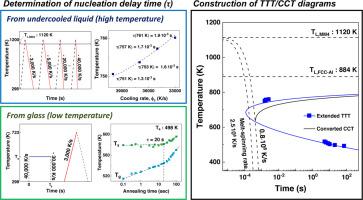Nucleation behavior of the primary FCC-Al phase in a Al86Ni10MM4 metallic glass
IF 9.3
1区 材料科学
Q1 MATERIALS SCIENCE, MULTIDISCIPLINARY
引用次数: 0
Abstract
The kinetics analysis of the heterogeneous nucleation behavior of primary FCC-Al in Al-based metallic glasses (MG) has been limited to a narrow temperature range below glass transition temperature due to the limited thermal test range available for conventional DSC (differential scanning calorimetry). Investigation of nucleation kinetics over wide temperature ranges has been a persistent challenge to clarify the kinetic competition between glass formation and nucleation of primary FCC-Al. To overcome this limitation, the Time-Temperature-Transition (TTT) diagram of primary FCC-Al in Al86Ni10MM4 (MM: mischmetal) MG has been determined by thermodynamic calculations and nucleation delay time data measured at the high (near melting temperature) and low (near glass transition temperature) temperature region by Flash DSC (FDSC). By analyzing the break point of the increasing glass transition and crystallization temperatures resulting from annealing, the nucleation delay time of FCC-Al in the temperature range of 493 K to 513 K was determined. Quenching a molten Al86Ni10MM4 MG at cooling rates over 33,000 K/s suppressed the formation of intermetallic phases, enabling the determination of the delay time of FCC-Al nucleation in the range of 750 K to 760 K from FDSC cooling curves by the additivity rule. Experimental delay time data, coupled with a statistical analysis on nucleation events during repeat runs observed at the cooling rate of 40,000K/s, provided valuable constraints on the assignment of kinetics parameters for the TTT diagram.


Al86Ni10MM4金属玻璃中初生FCC-Al相的成核行为
由于常规DSC(差示扫描量热法)的热测试范围有限,对al基金属玻璃(MG)中初代FCC-Al的非均相成核行为的动力学分析被限制在玻璃化转变温度以下的狭窄温度范围内。广泛温度范围内成核动力学的研究一直是一个持续的挑战,以阐明初级FCC-Al的玻璃形成和成核之间的动力学竞争。为了克服这一限制,通过热力学计算和在高(接近熔融温度)和低(接近玻璃化温度)温度区域用闪变DSC (FDSC)测量的成核延迟时间数据,确定了Al86Ni10MM4 (MM: mischmetal) MG中初级FCC-Al的时间-温度转变(TTT)图。通过分析退火引起的玻璃化转变和结晶温度升高的断点,确定了FCC-Al在493 ~ 513 K温度范围内的成核延迟时间。在超过33,000 K/s的冷却速率下对Al86Ni10MM4 MG熔体进行淬火,抑制了金属间相的形成,从而可以利用可加性规则从FDSC冷却曲线上确定FCC-Al在750 ~ 760 K范围内的成核延迟时间。实验延迟时间数据,加上在40,000K/s冷却速率下观察到的重复运行期间成核事件的统计分析,为TTT图的动力学参数分配提供了有价值的约束。
本文章由计算机程序翻译,如有差异,请以英文原文为准。
求助全文
约1分钟内获得全文
求助全文
来源期刊

Acta Materialia
工程技术-材料科学:综合
CiteScore
16.10
自引率
8.50%
发文量
801
审稿时长
53 days
期刊介绍:
Acta Materialia serves as a platform for publishing full-length, original papers and commissioned overviews that contribute to a profound understanding of the correlation between the processing, structure, and properties of inorganic materials. The journal seeks papers with high impact potential or those that significantly propel the field forward. The scope includes the atomic and molecular arrangements, chemical and electronic structures, and microstructure of materials, focusing on their mechanical or functional behavior across all length scales, including nanostructures.
 求助内容:
求助内容: 应助结果提醒方式:
应助结果提醒方式:


